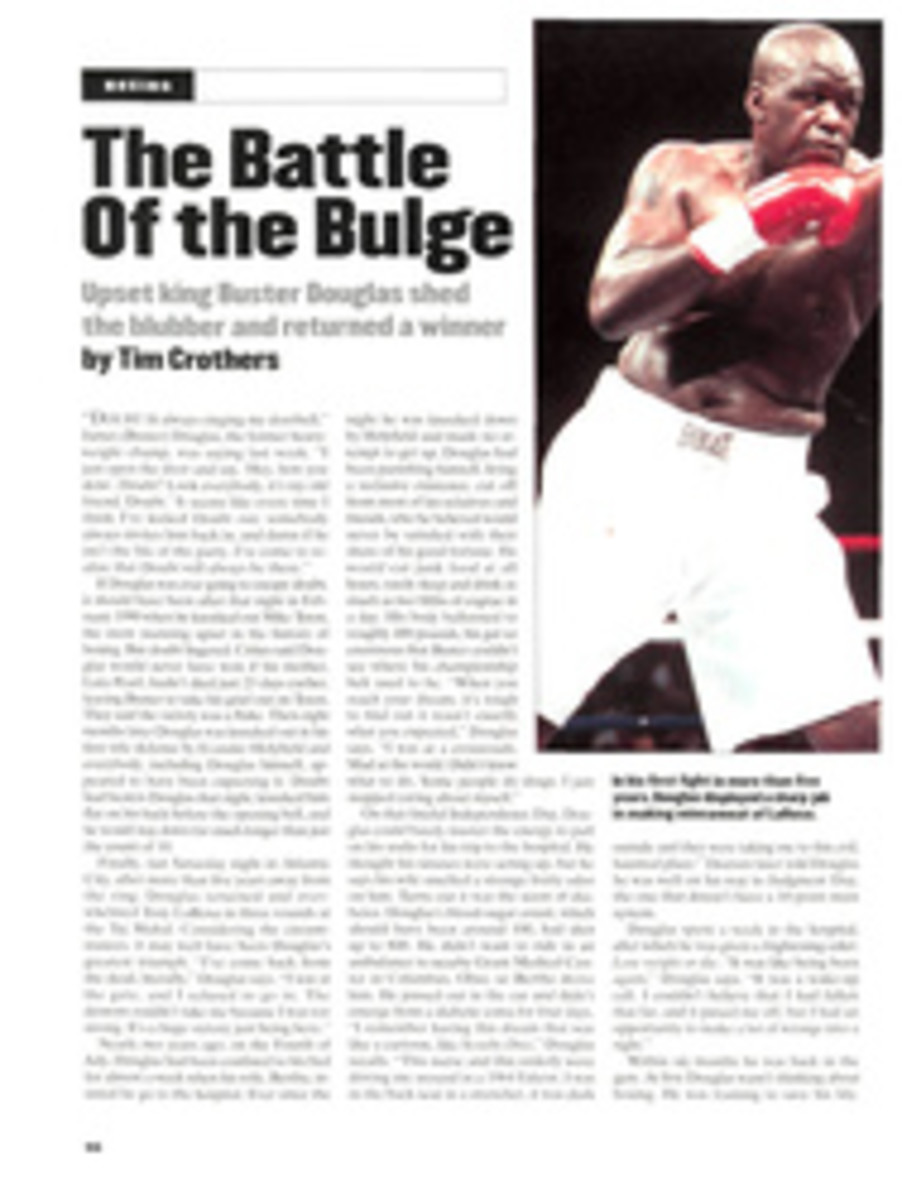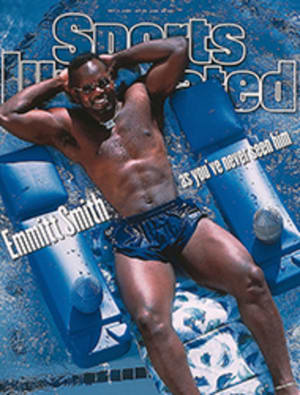
MORE TEAMS ARE FINDING BIG BATS IN AN UNLIKELY PLACE: BEHIND THE PLATE OH, TO BE YOUNG IN COLORADO
CATCHING FIRE
The phrase "good-hitting catcher" was once almost an oxymoron.
Most catchers were expected to concentrate on calling a game and
throwing out base stealers; hitting was their last priority.
Only two catchers in history (Bubbles Hargrave in 1926 and Ernie
Lombardi in '38 and '42) have won batting titles, and only one
earned the home run title (Johnny Bench, who did it twice, in
'70 and '71).
This season, however, a surprising number of catchers are making
an impact with their bats. The best known is the Dodgers' Mike
Piazza, who at week's end was leading the National League with a
.357 average. But two underpublicized and underrated catchers
have also emerged as probable All-Stars. The Mets' Todd Hundley
had 20 homers and 59 RBIs through Sunday, leading all major
league catchers in both categories, and the Mariners' Dan Wilson
led American League catchers in RBIs with 49 and was tied for
second in homers with 11.
Hundley and Wilson go back a long way. They grew up less than 10
miles apart just outside Chicago; they played high school
baseball against each other ("We were big rivals, we weren't the
greatest friends," says Wilson); they were also standout hockey
players, and each still dreams of playing for the Chicago
Blackhawks--Hundley at center ("I would pay them for a chance to
play in the NHL," he says) and Wilson at goalie. And even with
their new emphasis on hitting, neither player gives up a thing
on the defensive end of the game's most difficult position.
Hundley, the son of former major league catcher Randy Hundley,
was a good-field, no-hit prospect when Mets general manager Joe
McIlvaine first spotted him in 1986. "Todd and [White Sox
catcher] Ron Karkovice are the best defensive catchers I've ever
scouted," says McIlvaine, "but if you had told me then that
someday Todd would hit 20 homers in the big leagues, I'd have
said you were crazy."
Back then Hundley was a 17-year-old switch-hitter, and, at 145
pounds, "I was so small, it was scary," he says. The Mets took
him in the second round of the '87 draft, but they might have
worried when he hit .146 with one homer in 103 at bats his first
year in Class A ball, at Little Falls, N.Y.
"That park had a 420-foot fence in rightfield, and here's this
little guy trying to pull everything batting lefthanded," says
Mets hitting coach Tom McCraw, who was the club's roving minor
league hitting instructor that year. "The reason he has become
such a good hitter is he's using all of the field now, from both
sides of the plate."
But it took time for Hundley to stop trying to pull everything
and to fill out to his current 190 pounds. He didn't hit a lick
in brief trials with the Mets in 1990 and '91, then batted .209
in '92 and .228 in '93, his first two full years with the team.
For four years he heard from the New York media and members of
the organization: This guy is never going to hit. "You hear it
so often," says Hundley, "you start to believe it. But it
started to turn around in '94." Three months into that season he
became the Mets' every-day catcher, and while his batting
average still languished at .237, he showed he could hit with
power, finishing with 16 homers. Last year he hit .280 with 15
homers.
Like Hundley, Wilson was told for most of his early career that
he would never hit much. He hit nine homers last season, and
that was the most he had hit at any level, including three
college seasons at Minnesota, where he was a 3.0 student in
mechanical engineering. Wilson was a first-round pick of the
Reds in 1990, and in two brief stints with Cincinnati in 1992
and '93 he batted a combined .257 with no homers in 101 at bats.
But Mariners manager Lou Piniella, who managed the Reds from
1990 to '92, liked Wilson's defense and saw that he had
potential as a hitter, so he got the Reds to include Wilson in a
November '93 deal that sent Bobby Ayala to Seattle for Erik
Hanson and Bret Boone.
Wilson has almost perfect throwing mechanics. This season, with
Wilson behind the plate, Mariners opponents had been caught
stealing a remarkable 43.9% of the time through Sunday. But what
will probably get Wilson to the All-Star Game this year is his
bat. "Like Todd, I'm physically stronger than I used to be,"
Wilson says. "And I'm getting to know the league. I've done a
lot of work on my hitting, and it's nice to prove people wrong.
It takes away the sting. But even my wife asks me, 'What's the
deal with all these homers?' She's been all over me."
YOUNG AND GIFTED
In eight months the Rockies' Eric Young has gone from being one
of the worst defensive second basemen in the National League to
a reasonable facsimile of Jackie Robinson. Well, O.K., maybe not
that far. But at week's end Young was the league's third-leading
hitter, with a .338 average. "I don't pay attention to
statistics," he said when asked about that gaudy figure. Told
that the last second baseman to lead the National League in
hitting was Robinson, in 1949, Young's eyes lit up. "Now you got
me going," he said.
He has got the Rockies going too. Last year he batted .317 and
was a dynamic force at the top of the Colorado lineup. This
season he's even better, with an on-base percentage of .433
(fourth best in the league). "With our lineup, they've got to
pitch to me," says Young. "But I'm also coming into my own."
It is Young's improvement on defense, though, that is most
remarkable. Last year he tied the Dodgers' Delino DeShields for
the league lead in errors by second basemen, with 11, and was
reluctant to get his body in front of balls, opting instead to
sidesaddle many grounders. He was also clumsy around the bag on
the double play--all understandable, considering that he played
only one full season at second in the minors and then platooned
at that position when he was called up by the Dodgers in 1992.
He was taken by the Rockies in the expansion draft of 1992, but
Colorado shuttled him between second and the outfield before
moving him to the infield for good last June.
When he went to spring training this season, he was forced to
work exclusively on his fielding because his broken right hand
was in a splint and he couldn't swing a bat. For the first two
weeks he couldn't even throw, so he just took grounder after
grounder, sometimes 500 a day. The results have been
spectacular. Through Sunday, Young had made only one error in 55
games, and he has been much better at making the double play.
"I'm so much more relaxed out there." he says. "I always had the
notion last year that if I didn't play well defensively, I'd be
benched." Young has yet to be removed for defense in '96.
"That's good for anyone's ego," he says.
His improvement isn't surprising, considering his athleticism.
Despite being only 5'9" and weighing 170 pounds, Young was the
leading receiver on the Rutgers football team in 1988. "I'm a
Dave Meggett type," he says. "I can see myself in the NFL, in a
third-down situation going up against a linebacker and putting
on some moves." But baseball is his sport now, and he's playing
it at an extremely high level.
SHORT HOPS
Phillies general manager Lee Thomas once said that if you could
design the perfect baseball player, he would look like Mark
Whiten, who has all the tools you would want in a player: great
power, great arm, speed. Only problem is, Whiten hasn't
produced, and last week the Phillies released him. Whiten, 29,
still goes to the plate expecting fastballs, while pitchers feed
him a steady diet of breaking balls. Thus he falls behind in the
count and invariably ends up chasing pitches out of the strike
zone. But there is always some team that thinks it can harness
his potential. Sure enough, the Braves signed him Sunday,
becoming his sixth major league team in the last six years....
The Padres' collapse is staggering. They were 35-20 and in first
place in the NL West by 6 1/2 games on June 1. Then they lost 17
of their next 21, leaving them in a second-place tie with
Colorado at week's end, two games behind the Dodgers.
COLOR PHOTO: CHUCK SOLOMON Hundley was always a top defensive catcher, but now he has also become a dangerous slugger. [Todd Hundley attempting to catch baseball barehanded]
COLOR PHOTO: RUSTY KENNEDY/AP A fractured hand turned out to be a good break for Young, who became a better second baseman as a result. [Eric Young and others in game]

